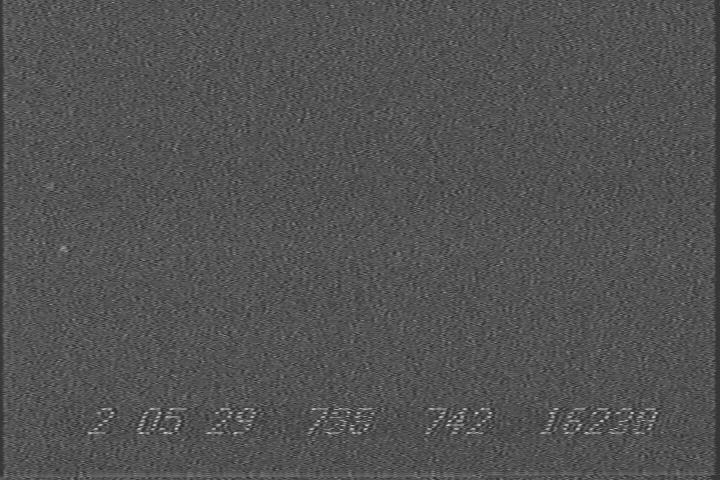
 Copyright © Michael Richmond.
This work is licensed under a Creative Commons License.
Copyright © Michael Richmond.
This work is licensed under a Creative Commons License.
Table of contents:
Steve Messner observed the asteroid (304) Olga occult the star GSC 0176-00965 = USNOB1.0 0970-0159182 on UT Feb 7, 2006. His location was the Sola Fide Observatory, near Austin, MN. Latitude +43.6165, longitude W 92.9761, altitude 1180 feet.
Steve wrote to me describing this analysis of the videotape:
I have a recording of an occultation by 304 Olga in Feb. Between bad seeing and haze, the mag 12.2 star was on the edge of visibility. Also I didn't use my trusty old VCR but instead used the one at that observatory and I believe the tape is a little more noisy than normal. When I play the AVI you can see the occultation happen but playing back frame by frame or field by field the star gets lost in the noise. I was wondering if you would be so kind and let me send a copy of that also for you to look at. It may very well be too poor to get data any better than visually playing it back over and over and factoring in a personal equation. Not a bad option anyway.
Some time after the event, he kindly sent digitized versions of his video record to me. First, I broke the video clip into individual frames, using MPlayer. The result was a set of JPEG images, each 720 x 480 pixels in size. Each frame had a KIWI OSD timestamp at the bottom. My analysis used frames, composed of two superimposed fields.
Below is a sample frames, index number 1, from his recording.

As you can see, the signal-to-noise ratio is rather low, due to the faintness of the stars in the field. Below is a sum of 29 consecutive frames, which shows objects more clearly.
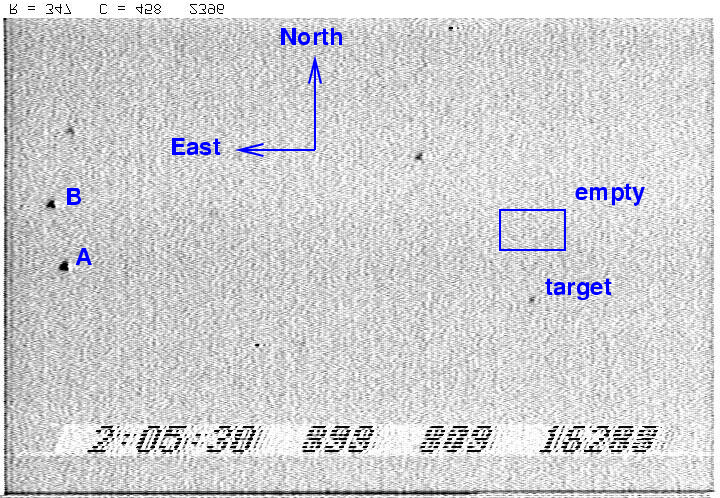
I have labelled two comparison stars (A and B), the target, and a region of empty sky. I will measure the signal from each of these regions of each image.
In order to process the data, I
There were several stars visible in the video. I chose the brightest, which I call "A" in the charts above, as a primary reference. Star "B" serves as a check on star "A". The empty region shows what sort of "signal" will appear from a blank piece of sky; if all goes well, it will produce zero integrated light.
For each of the frames, I
Here are quick views of the results.
First, the entire light curve for the three real stars:
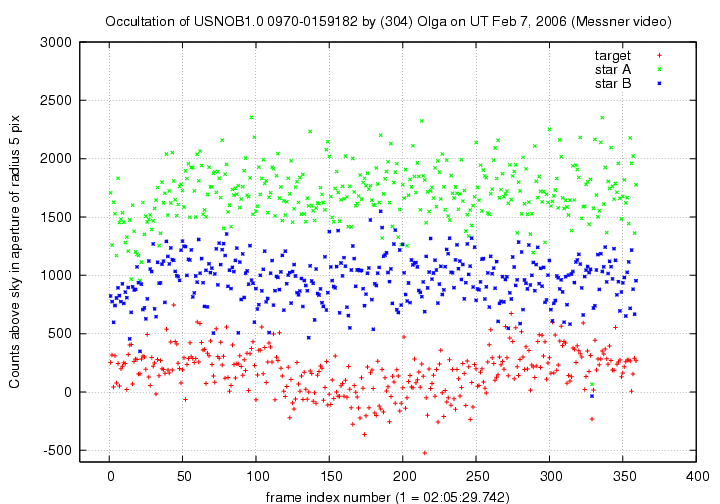
Note that the target star does appear to fade to zero light for some period.
Now, let's look at the light curve for the target star and a nearby region of blank sky. I have shifted the empty region's data for clarity.
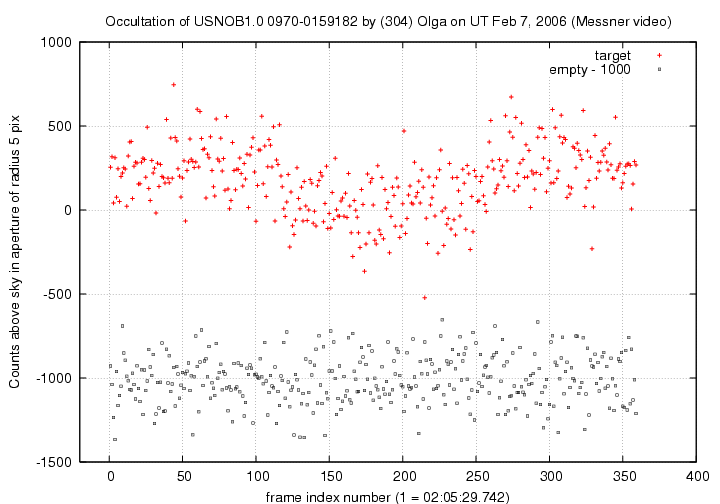
The blank region does remain constant, with a large scatter, over the duration of the videotape.
You can grab the data in multi-column ASCII text files below. The columns are
col quantity
------------------------------
1 frame index
2,3 flux of reference star "A" in 4-pixel-radius aperture,
and estimate of uncertainty in that flux
4,5 ditto 5-pixel aperture
6,7 ditto 6-pixel aperture
8,9 flux of check star "B" in 4-pixel-radius aperture,
and estimate of uncertainty in that flux
10,11 ditto 5-pixel aperture
12,13 ditto 6-pixel aperture
14,15 flux of target star in 4-pixel-radius aperture,
and estimate of uncertainty in that flux
16,17 ditto 5-pixel aperture
18,19 ditto 6-pixel aperture
20,21 flux of empty region in 4-pixel-radius aperture,
and estimate of uncertainty in that flux
22,23 ditto 5-pixel aperture
24,25 ditto 6-pixel aperture
I conclude that Messner did record an occultation. However, determining its start and end points is a tough business, due to the very low signal-to-noise ratio. To increase the photometric precision, I broke the videotape into segments of 5 consecutive (non-overlapping) frames, and co-added the frames within each segment. This should yield better photometry, at the cost of a reduction in time resolution.
Here is the light curve of the stars in the coadded images. Again, we see that the target star did decrease to zero for a period, then recover.
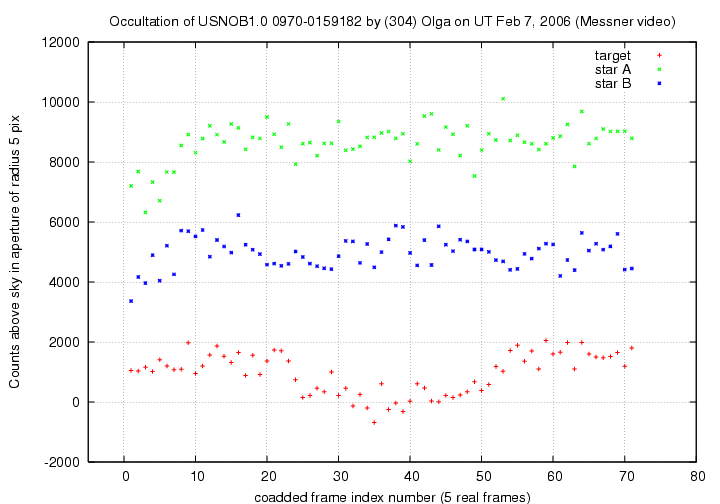
For comparison, here are the stars and the empty region in the coadded frames:
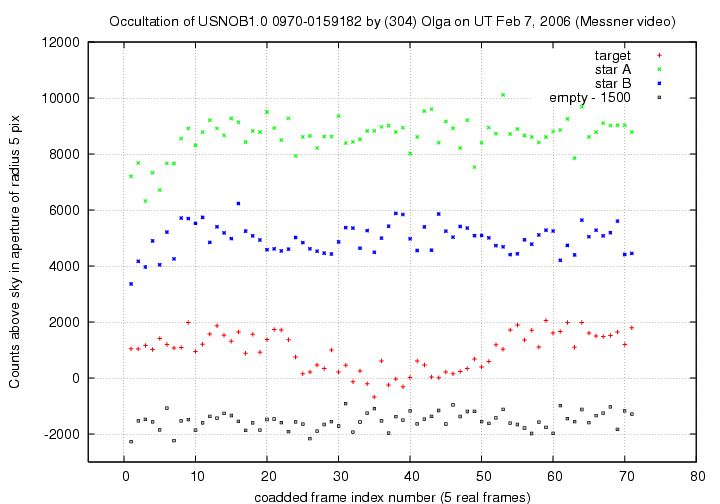
Again, I would claim that the target star does disappear. I leave it to the reader to estimate the best times for the disappearance and re-appearance.
You can grab the data in multi-column ASCII text files below. The columns are
col quantity
------------------------------
1 frame index
2,3 flux of reference star "A" in 4-pixel-radius aperture,
and estimate of uncertainty in that flux
4,5 ditto 5-pixel aperture
6,7 ditto 6-pixel aperture
8,9 flux of check star "B" in 4-pixel-radius aperture,
and estimate of uncertainty in that flux
10,11 ditto 5-pixel aperture
12,13 ditto 6-pixel aperture
14,15 flux of target star in 4-pixel-radius aperture,
and estimate of uncertainty in that flux
16,17 ditto 5-pixel aperture
18,19 ditto 6-pixel aperture
20,21 flux of empty region in 4-pixel-radius aperture,
and estimate of uncertainty in that flux
22,23 ditto 5-pixel aperture
24,25 ditto 6-pixel aperture
 Copyright © Michael Richmond.
This work is licensed under a Creative Commons License.
Copyright © Michael Richmond.
This work is licensed under a Creative Commons License.